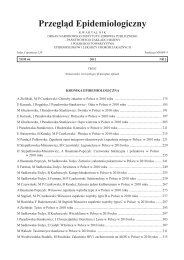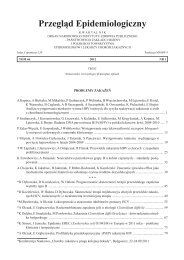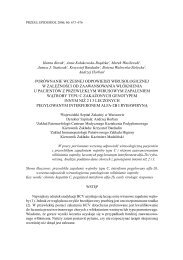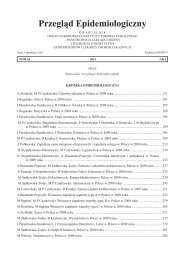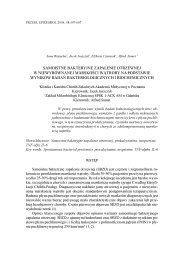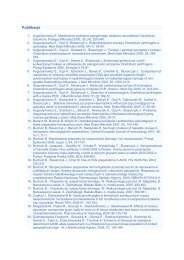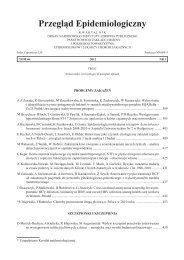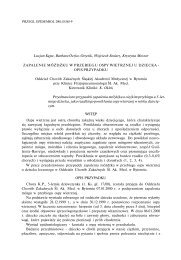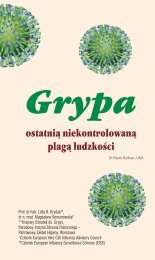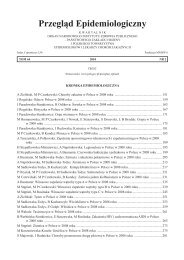Rok 2011, tom 65, nr 4 - Państwowy Zakład Higieny
Rok 2011, tom 65, nr 4 - Państwowy Zakład Higieny
Rok 2011, tom 65, nr 4 - Państwowy Zakład Higieny
You also want an ePaper? Increase the reach of your titles
YUMPU automatically turns print PDFs into web optimized ePapers that Google loves.
PRZEGL EPIDEMIOL <strong>2011</strong>; <strong>65</strong>: 599 - 603 Problemy zakażeń<br />
Małgorzata Raś - Noryńska a , Joanna Białkowska b , Rajmund Sokół a , Krystyna Piskorz–Ogórek b<br />
PArASItoLoGICAL StooL EXAmInAtIon From CHILDrEn WItHoUt tHE<br />
tYPICAL SYmP<strong>tom</strong>S oF PArASItIC DISEASE<br />
BADANIA PARAZYTOLOGICZNE KAŁU DZIECI BEZ TYPOWYCH OBJAWÓW<br />
CHORÓB PASOŻYTNICZYCH<br />
Katedra Parazytologii i Chorób Inwazyjnych, Wydział Medycyny Weterynaryjnej UWM Olsztyn a ,<br />
Wojewódzki Specjalistyczny Szpital Dziecięcy Olsztyn, Wydział Nauk Medycznych UWM Olsztyn b<br />
STRESZCZENIE<br />
Inwazje pasożytów jelitowych u ludzi mają najczęściej<br />
przebieg podkliniczny i w związku z tym są<br />
rzadko rozpoznawane. Szereg nieswoistych objawów<br />
towarzyszących inwazji często przypisywane jest innym<br />
jednostkom chorobowym. Wykonane w ramach<br />
doświadczenia badanie parazytologiczne kału wykazało<br />
obecność pasożytów jelitowych w 21,64% prób. U osób<br />
zgłaszających współwystępowanie 6 różnych objawów<br />
chorobowych odsetek prób dodatnich parazytologicznie<br />
wyniósł 80%. Wynik ten wskazuje na celowość wykonywania<br />
badania koproskopowego w przypadkach<br />
diagnostycznie niejasnych, szczególnie u pacjentów<br />
pediatrycznych. Inwazje pasożytnicze kojarzone są<br />
z rezerwuarem zwierzęcym i zoonozami, co było punktem<br />
wyjścia dla zestawienia wyników badania prób<br />
pochodzących od osób utrzymujących w gospodarstwie<br />
domowym zwierzęta z wynikami badania prób od osób<br />
nieposiadających zwierząt. Uzyskany wynik wskazuje<br />
na brak bezpośredniej korelacji między stałą stycznością<br />
ze zwierzętami w domu, a częstotliwością występowania<br />
inwazji pasożytniczej.<br />
Słowa kluczowe: inwazje pasożytnicze, badanie parazytologiczne,<br />
objawy ogólne<br />
INTRODUCTION<br />
Gastrointestinal parasites are organisms that colonize<br />
the human body and cause damage by depriving<br />
the host of intestinal proteins, secreting poisonous metabolic<br />
waste and leading to irritations. Most intestinal<br />
infestations are sub-clinical, therefore, they are rarely<br />
diagnosed. General symp<strong>tom</strong>s of parasitic invasions,<br />
noted primarily in children, are often attributed to allergic<br />
or metabolic factors, or nutritional deficiencies.<br />
The aim of the study was to examine fecal samples from<br />
healthy children as well as children showing various<br />
nonspecific symp<strong>tom</strong>s and to determine the percentage<br />
of associated parasitic infections.<br />
ABSTRACT<br />
Most parasitic intestinal infestations in humans are<br />
sub-clinical and, therefore, they are rarely diagnosed.<br />
A number of general, non-specific symp<strong>tom</strong>s of parasitic<br />
invasions are often attributed to other diseases.<br />
A parasitological examination of feces performed as<br />
part of this study confirmed the presence of intestinal<br />
parasites in 21.6% of samples. Among the patients<br />
who reported 6 different symp<strong>tom</strong>s, the percentage of<br />
parasite-positive samples reached 80%. The obtained<br />
results suggest that coproscopic tests may establish<br />
the diagnosis in unclear cases, particularly in children.<br />
Many parasitic invasions are zoonoses and pets owe<br />
a reservoir. In view of the above, the results for pet<br />
owners and non-pet owners were compared in the study.<br />
There was no direct correlation between pet ownership<br />
and the incidence of parasitic infections.<br />
Key words: parasitic infections, parasitological examinations,<br />
general symp<strong>tom</strong>s<br />
Children are more likely to fall victim to parasitic<br />
invasions because their immune mechanisms are not yet<br />
been fully developed, they are characterized by greater<br />
mobility than adults, they come into frequent contact<br />
with peers in preschool institutions and schools and they<br />
have poor hygiene habits. (1, 2) Other risk factors include<br />
contacts with pets, including in playgrounds. (1, 3)<br />
Parasitic infections have more serious consequences<br />
for children than for adults. The most common<br />
manifestations include the inhibition of psychological<br />
and physical development (1, 4, 5), gastro-intestinal<br />
disorders, allergies (6), skin lesions (7), deterioration<br />
of general well-being, which often translates into poor



